To hang heavy objects securely, start by weighing the item to guarantee the right support. Use a stud finder to locate wall studs for maximum stability, as they can handle weights up to 100 pounds with screws. If no studs are accessible, opt for drywall anchors or toggle anchors that can support heavier items. Always test their stability before hanging. There are more innovative methods available, and you’ll discover them if you explore further.
Key Takeaways
- Accurately weigh heavy objects to ensure proper support and stability before hanging them on walls.
- Locate wall studs using a stud finder and secure items with 2-inch screws for maximum support.
- Use drywall anchors or toggle anchors for items without wall studs, ensuring they are rated for the item’s weight.
- Consider using a French cleat system for heavy items, providing stability and ease of leveling.
- Test all anchors and mounts for stability before hanging items to prevent accidents or damage.
Weighing the Item and Safety Considerations
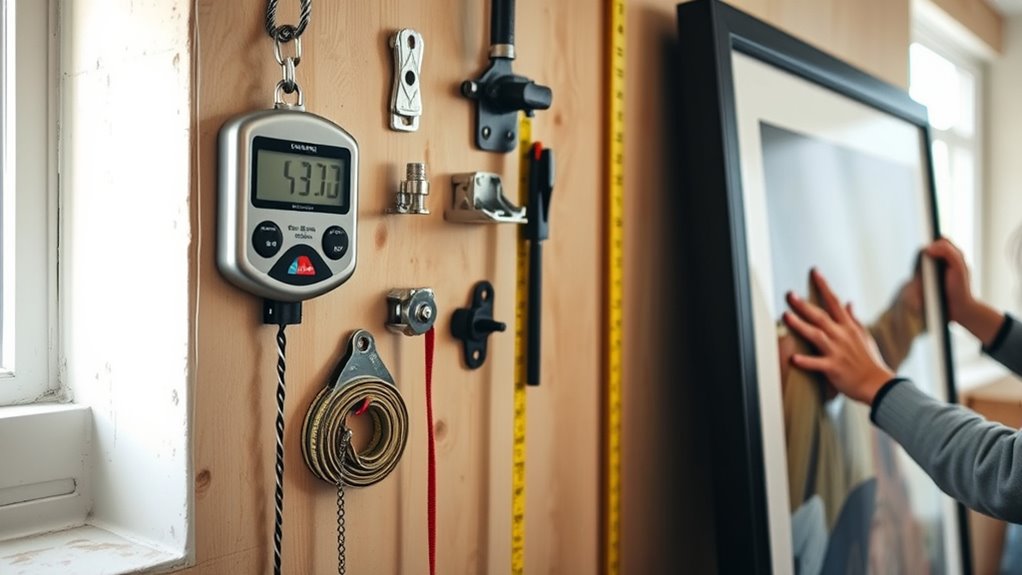
When you’re ready to hang a heavy object on your wall, weighing the item accurately is essential for safety and proper installation. You can use a bathroom scale by first weighing yourself, then weighing yourself while holding the item to find the difference in weight.
For larger or awkward items, consider using a specialized weight measuring gadget for better accuracy. Always prioritize safety by ensuring the item is stable and secure while you weigh it to prevent accidents. Knowing the exact weight influences your choice of hanging method and the type of anchors or screws needed for secure installation. If you’re unsure about the weight, opt for heavier-duty anchors and supports to accommodate any potential discrepancies. Additionally, consider the safety and quality standards that apply when selecting anchors to ensure a secure installation. Using heavier-duty anchors helps to maintain potency of the installation, creating a more harmonious living environment. Emphasizing emotional well-being is crucial in all aspects of home adjustments, as it can create a more harmonious living environment. Furthermore, checking the local building codes ensures that your installation meets safety regulations for heavy objects.
Finding a Stud and Using Anchors
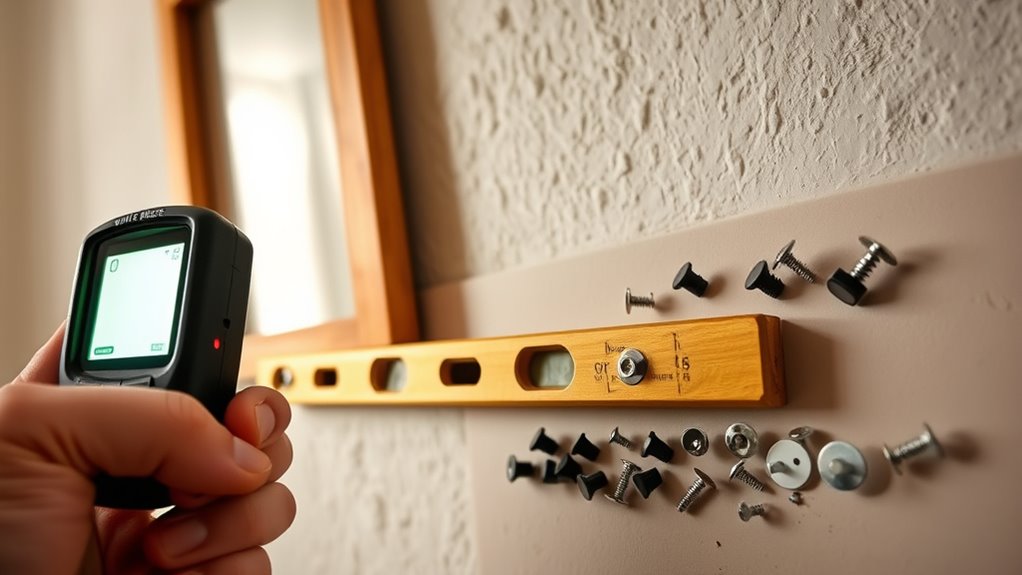
Locating a stud in your wall is essential for securely hanging heavy objects. Wall studs are typically spaced 16 to 24 inches apart and provide the strongest support. Using a stud finder helps you locate them without damaging any electrical wiring. Once you find a stud, you can drive a 2-inch threaded screw into it, which can support up to 100 pounds. Additionally, higher contrast ratios in the materials used can enhance the visual appeal of the hung items. Research shows that the use of best home security systems can also provide peace of mind when hanging valuable items.
If you can’t find a stud, a drywall anchor is your next best option. For heavy items, consider using Molly bolts, which can hold up to 50 pounds. For lighter items, plastic anchors work well, but always aim for at least one stud for added security. Additionally, understanding local building codes can help inform your choices about what and how to hang items on your walls. Effective ventilation can also help maintain wall integrity by reducing moisture accumulation behind heavy objects.
Properly securing your items guarantees they remain safe and stable.
French Cleats for Heavy Items

If you’ve secured your wall with studs or anchors, consider using French cleats for hanging heavy items. This robust wall-hanging system can support items weighing up to 300 pounds when installed correctly. It consists of two interlocking pieces—one on the wall and the other on the item—making leveling and removal easy. Additionally, backyard greenhouses can benefit from using French cleats to securely hang tools and supplies. French cleats also offer a simple solution for adhering to local building codes when mounting items in a tiny house, ensuring safety and compliance.
Here are some benefits of using French cleats for hanging heavy objects:
- Strong support: Ideal for mirrors, cabinets, and large artwork.
- Easy installation: One person can hang and adjust items efficiently.
- Stable mounting: Provides safety and stability for your heavy items. Additionally, using advanced technology in your mounting solutions can enhance their effectiveness and reliability.
Using French cleats not only enhances your decor but guarantees that your heavy items are securely displayed. Additionally, similar to Kia tuning options, French cleats can be customized to fit various needs and preferences.
Command Strips for Lightweight Options

For hanging lightweight items like small pictures or decorations, Command strips are an excellent choice. They support weights of up to 16 pounds, making them the number one option for your lightweight needs. Plus, they’re damage-free, perfect for renters or anyone wanting to avoid wall repairs. Regular use of vacuuming techniques helps maintain the appearance of your walls by preventing dust and debris buildup. To enhance your wall decor, consider incorporating macramé wall hangings to add texture and visual interest. Additionally, using proper space optimization can help ensure your wall decor is both functional and aesthetically pleasing.
To guarantee the best results, clean the wall surface before applying the strips and follow the manufacturer’s instructions. Here’s a quick overview of Command strips:
| Feature | Details |
|---|---|
| Weight Capacity | Up to 16 pounds |
| Application | Clean wall and follow instructions |
| Removal | Pull tab straight down |
| Versatility | Various sizes and designs |
With these tips, you can confidently decorate without worry! Additionally, using Command strips can help you avoid the risk of damage associated with traditional hanging methods.
Method 1: Hanging Using Wall Studs
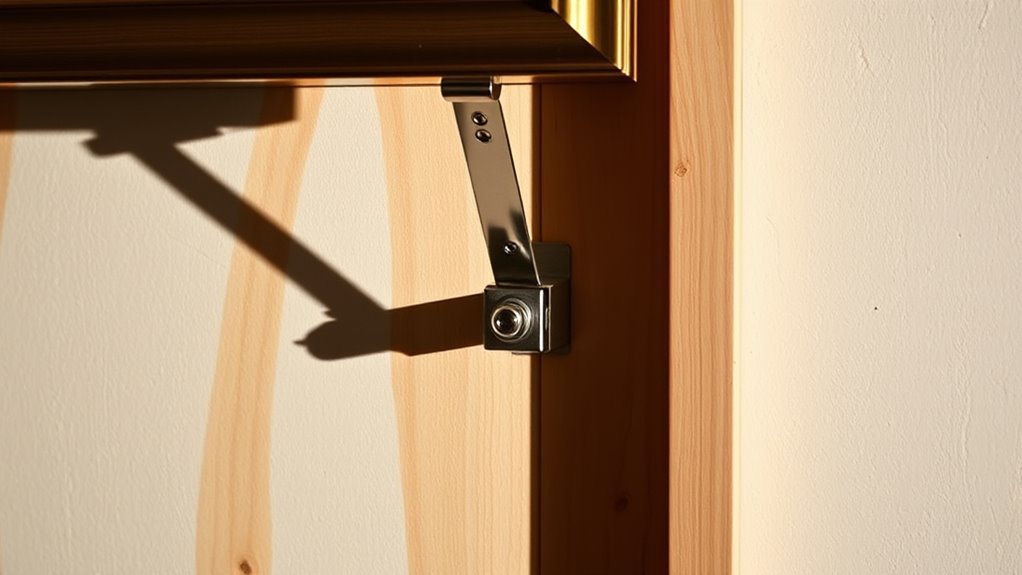
When you’re ready to hang your heavy items, finding wall studs is your first step. Securely installing your hardware into these studs guarantees long-term support and stability. This method not only prevents damage to your walls but also gives you peace of mind that your items are safely anchored. Additionally, using proper installation techniques can support a healthier lifestyle by ensuring your space remains organized and free from hazards. Furthermore, ensuring proper insulation in your walls can also enhance overall energy efficiency in your home. Moreover, using locally sourced wood for your wood stove can significantly reduce transportation-related carbon footprint, further contributing to a sustainable living environment. By creating a structured routine for your home organization, you can foster a more balanced and resilient living space.
Finding Wall Studs
How can you guarantee your heavy objects stay securely on the wall? The key is finding wall studs, which provide the strongest support. Here’s how to locate them effectively:
- Use a stud finder to accurately pinpoint the studs, avoiding any electrical wiring or plumbing.
- Remember that studs are typically spaced 16 to 24 inches apart, so measure carefully. Additionally, ensuring that your wall has appropriate insulation levels can enhance the overall stability of your hanging items.
- For heavy items, make sure to anchor at least one screw directly into a stud, as a 2-inch threaded screw can support up to 100 pounds. Additionally, consider using rustic lighting to enhance the aesthetic of your space while ensuring that your heavy items are securely hung.
Installing Hardware Securely
After locating the wall studs, you can confidently install your hardware for hanging heavy objects.
Use a stud finder to guarantee you steer clear of electrical wiring, and remember that studs are typically spaced 16 to 24 inches apart.
When securing your hardware, opt for a 2-inch threaded screw, which can support up to 100 pounds. This is vital for heavy items, so choose heavy-duty hardware designed for wall studs.
To make certain your object hangs straight, don’t forget to use a level while mounting it.
If necessary, pre-drill pilot holes to avoid splitting the wood, making the installation smoother.
Following these steps will guarantee your heavy objects are hung securely and safely.
Long-Term Support Benefits
Since hanging heavy objects using wall studs is the most reliable method, you can trust that your items will remain secure over time.
This approach offers significant long-term support benefits, ensuring your heavy item stays put without worrying about wall damage or falling.
Here are a few reasons to choose wall studs for your installation:
- Stability: Direct installation into studs provides strong reinforcement for weights up to 100 pounds.
- Simplicity: You won’t need additional anchors, making the installation process straightforward.
- Safety: Using a stud finder to locate wall studs reduces the risk of hitting electrical wiring, keeping your project safe.
Method 2: Utilizing Drywall Anchors

When you can’t find wall studs, drywall anchors are your best bet for hanging heavy items securely.
It’s important to select the right anchor based on the weight of your item and follow proper installation techniques for maximum stability.
Let’s explore how to choose the appropriate anchors and install them correctly to guarantee your items stay safely on the wall.
Selecting Appropriate Anchors
How do you guarantee that heavy objects stay securely mounted on your walls? Selecting appropriate anchors is essential, especially when using drywall anchors.
Start by weighing your item to choose an anchor with the right weight rating, typically between 30 to 75 pounds or more. Even though some anchors might seem sufficient, always opt for those with higher ratings for added security.
Here are a few tips:
- Use multiple anchors to evenly distribute weight.
- Create a dimple in the wall for a proper fit, making certain the anchor sits flush.
- Test the strength of the anchors by gently pulling on them before hanging.
These steps guarantee that your heavy items remain stable and secure on your walls.
Installation Techniques Explained
To effectively hang heavy objects on drywall, you’ll need to master the installation of drywall anchors. I’m going to share essential steps for a secure setup. First, create a small dimple in the wall where you’ll insert the anchor. Confirm it sits flush for maximum support. Always weigh your item to select the right anchor, which typically supports between 30 to 75 pounds. Using multiple anchors enhances stability and balance, keeping your item straight. Before hanging, test the anchors by applying gentle pressure to confirm they can bear the load. Below is a quick reference table:
| Anchor Type | Weight Capacity |
|---|---|
| Plastic Anchor | Up to 30 lbs |
| Metal Toggle | Up to 75 lbs |
| Screw-In Anchor | Up to 50 lbs |
| Molly Bolt | Up to 50 lbs |
| Self-Drilling | Up to 40 lbs |
Creative Use of Drywall Anchors

While you might think drywall anchors are just for hanging pictures, they can actually be creatively used to support a range of heavy objects, from shelves to decorative mirrors.
When you’re dealing with extremely heavy items, choosing the right anchors is crucial. Here are some tips to maximize their potential:
- Use Molly bolts for items weighing up to 50 pounds.
- Create a dimple in the wall to guarantee the anchor sits flush.
- Distribute the weight evenly by using multiple anchors for larger pieces.
Method 3: Installing Toggle Anchors

When you’re ready to hang something heavy, toggle anchors are a reliable choice.
First, you’ll need to drill a hole and insert the toggle bar, which provides impressive support of up to 100 pounds.
Installation Steps Overview
If you need to hang heavy objects on drywall and can’t access wall studs, installing toggle anchors is a reliable solution. Here’s an installation steps overview to guarantee you do it right:
- Create a pilot hole: Use a drill to make a small hole in the drywall where you want to hang on the wall.
- Insert the toggle bar: Push the toggle bar through the hole and tighten it until it secures against the back of the drywall.
- Test the anchor’s hold: Pull down on the toggle to make sure it’s fully opened and stable before hanging your item.
Always remember to follow the manufacturer’s instructions for best results. This method supports up to 100 pounds, making it perfect for heavy items!
Weight Capacity Considerations
Understanding weight capacity is essential when installing toggle anchors for hanging heavy objects. Toggle anchors can support items weighing up to 100 pounds if installed correctly.
When you create a dimple in the drywall to insert the toggle bar, it expands behind the wall, providing secure anchoring. This mechanism distributes the weight evenly, enhancing stability.
Before hanging anything, always test the toggle anchor’s stability; you want to avoid any damage to your wall or the object. For maximum safety, choose toggle anchors with a weight rating that exceeds the actual weight of what you’re hanging.
Testing Anchor Stability Before Hanging
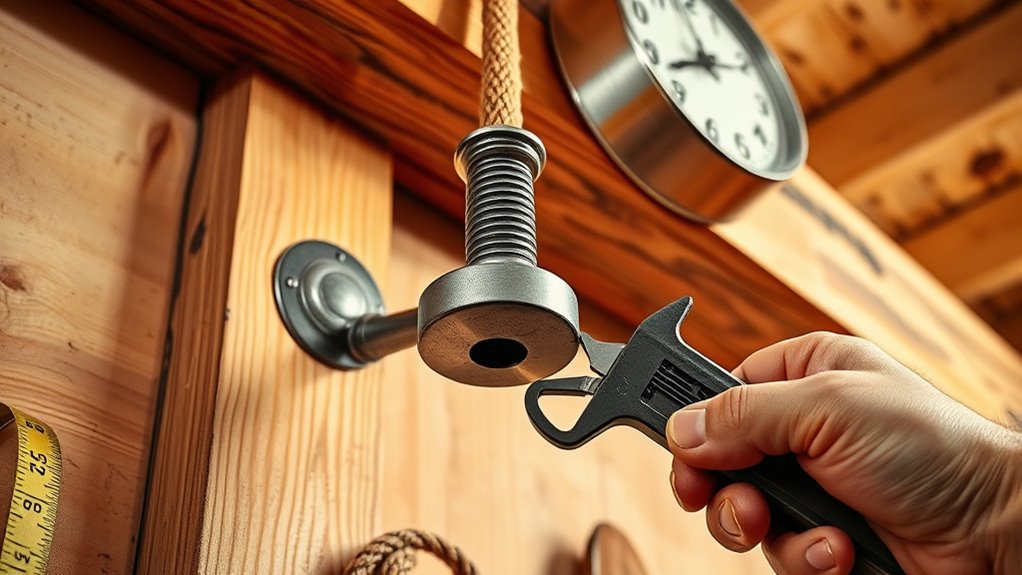
Before you hang any heavy objects, it’s crucial to test the stability of your anchors to confirm they’ll hold up under weight.
Take the time to verify your anchors are secure, so you won’t face any surprises next time. Here’s how you can do that:
- For drywall anchors: Gently tug on the anchor after installation to check for movement.
- For toggle anchors: Lightly pull to confirm the toggle bar is fully expanded behind the drywall.
- Use a weight measuring gadget: Weigh your item accurately to verify it’s matched with the correct anchor type and rating.
Always perform a stability test with the item off the wall first.
If it withstands the pressure, you’re good to hang your item securely!
Engaging With the DIY Community
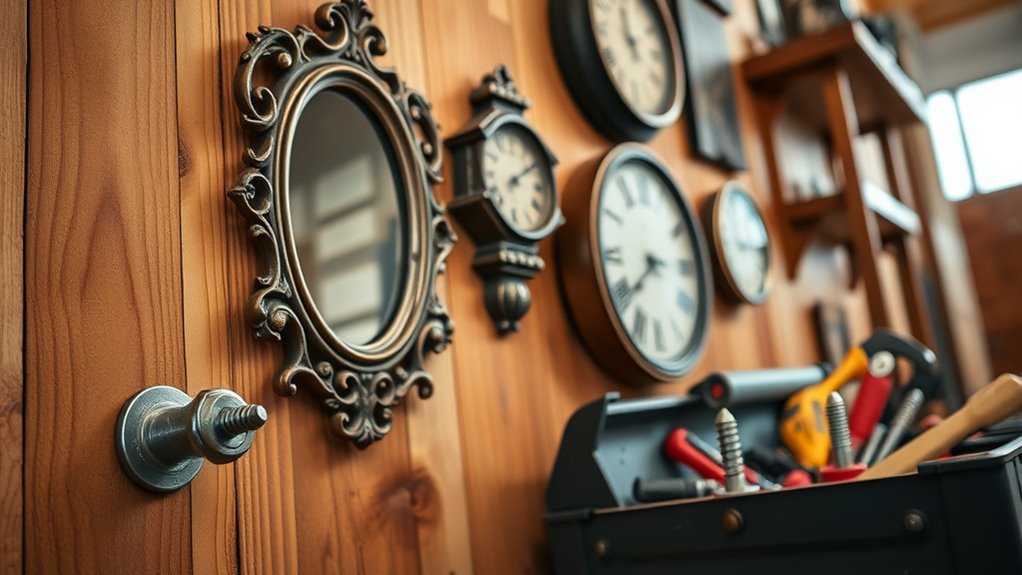
Many DIY enthusiasts find that engaging with the community can greatly enhance their projects, especially when it comes to hanging heavy objects securely.
By participating in online forums or social media groups, you can gather valuable insights and tips from others who’ve faced similar challenges. Check out comment sections on DIY blogs and videos; they often provide a supportive environment where you can ask questions and share your own methods.
Remember, number three on the list of benefits is inspiration—seeing others’ creative uses of heavy items can spark new ideas for your projects.
Joining link-up parties and community challenges is another great way to showcase your work, receive feedback, and connect with like-minded DIYers who share your passion.
Frequently Asked Questions
How to Hang Something Really Heavy on the Wall?
When you’re hanging something really heavy on the wall, start by finding a wall stud, since it provides the best support.
If there’s no stud, use heavy-duty drywall anchors, like Molly bolts or toggle anchors, to secure your item.
Weigh your object first to choose the right hardware.
Always follow proper installation techniques, like creating a dimple for anchors, and test their stability before you place the heavy item on the wall.
How Do You Hang 100 Lbs on Drywall?
Hanging a 100 lbs object on drywall can feel intimidating, yet it’s manageable with the right approach. You’ll need toggle anchors to distribute the weight effectively.
First, weigh your item to confirm it’s 100 lbs. Drill a hole, insert the toggle bar, and secure it against the wall.
After installation, test the anchors by gradually applying pressure. For extra safety, consider using wall studs alongside the anchors for enhanced support.
What Is Too Heavy to Hang on a Wall?
When you’re deciding what’s too heavy to hang on a wall, consider the weight limits of your wall type.
Generally, if an item weighs over 50 pounds, you need to be cautious. Items above 100 pounds usually require special anchors or direct support from wall studs.
Always check the combined weight of multiple items too, since exceeding the limits can cause damage or even accidents.
It’s better to be safe than sorry!
How Much Weight Can You Hang on an Internal Wall?
You can typically hang between 10 to 50 pounds per square foot on internal walls, depending on the wall’s material and construction.
If you find wall studs, you’ll have a reliable support that can hold around 100 pounds with the right hardware.
For heavier items, consider using appropriate wall anchors like Molly bolts or toggle anchors, which can safely support up to 50 and 100 pounds, respectively, ensuring your items stay securely in place.
Conclusion
In wrapping up, hanging heavy objects on your walls doesn’t have to be an intimidating task. With a little planning and the right tools, you can elevate your space while keeping everything secure. Remember, whether you’re finding a stud or employing clever anchors, it’s all about giving your treasures a sturdy home. So, roll up your sleeves, trust your instincts, and let your creativity shine as you transform your walls into a showcase of style and strength!









